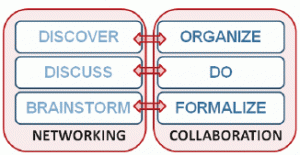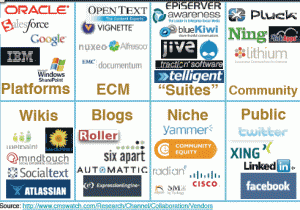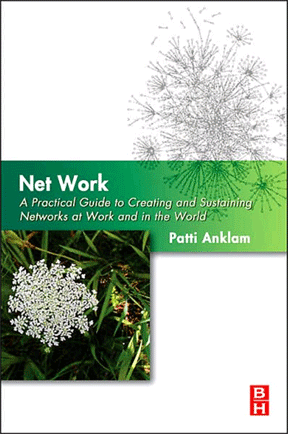New themes for “Enterprise 2.0”
I spent two days at the Enterprise 2.0 conference in Boston last week to get the pulse of this emergent ecosystem of vendors, practitioners, consultants, and thought leaders and to connect with many of my favorite fellow travelers from the KM world. A lot has been written already about the conference, and as usual the earliest blog posts were reportage and those coming along this week a bit more reflective. See especially Cecil Dijoux, Esteban Kolsky, and Sameer Patel (so far).
On the vendor side, it’s clear that as the market is maturing; it’s all about the platform now (see my previous post) and there are a number to choose from. (Some look a lot like intranets, but I think we’re supposed to think that intranets are passé. To me, the intranet is the “home page of the enterprise,” social or not; it has to be where eyeballs start the day, where hands go to search, and where people connect with people and content.)
What felt different (and this has been said by many) is the shift in tone that occurred based on the selection of keynote speakers away from vendor pitches (with a glaring exception or two) and toward thinking about the nature of business and work. The Wall Street Journal picked up on Jive‘s CTO’s comment “that the emphasis has shifted toward business outcomes” in its article Enterprise 2.0 is growing up.” But it was not just about business outcomes.
It was also about the nature of business, relationships (companies <-> customers <-> employees), and some pretty simple principles of management. I had picked Mike Gotta‘s workshop, Organization Next, to attend on Monday, bypassing (except for an occasional drop-in) the Blackbelt practitioner’s session. (Ok, so I was just looking for a larger picture all along and at least at this E2.0 conference I found a lot of good stuff to listen to.) Mike’s workshop was HR-focused, looking at ways that HR managers are coping with/thinking about responding to changes in the employer/employee relationship. Daniel Rasmus did a nifty scenario planning workshop that brought home the number of uncertainties that exist about the world we live in. Sara Roberts of Roberts Golden also did some great interactive exercises around organizational agility and change management. It didn’t feel like a technology conference at all.
(Sara also did a terrific keynote on Wednesday, “why employees are/should be managing the company,” introducing the notion of working within a complex system: setting the proper boundaries that enable leadership to emerge. She started with the metaphor of streams of humanity on the sidewalks of New York and how people can move in and out of the stream easily.)
In his elegantly constructed Tuesday morning keynote, the always inspiring John Hagel nimbly set the tone for a business-focused conference. Starting with last year’s big E2.0 question “How do we get adoption for social software?” he linked adoption to passion and performance (“If you are interested in performance you have to be interested in passion”). People who are engaged in activities they are passionate about will connect with other people — and if you’ve got the platform available, and right, then they will use it in conjunction with passion. The only metric that matters is engaging passion.
(Later in the morning, Bryce Williams from Eli Lilly talked about how social collaboration was enabling emergent leadership in the organization. In his terrific stories, he emphasized how people succeeded because they were able to follow their passions. In the afternoon, in a session on innovation, Roy Rosin from Intuit talked about building an innovation environment: “[it means…] letting people build on their passions.” Sara Roberts said, in her workshop on Monday: “Meaning is the new money.” )
Rachel Happe, of the Community Roundtable, talked about the strategic imperative of communities: “Relationship and Culture are the only sustainable advantage.” And, she insists, that it takes time to cultivate communities, that our tools and technologies are pushing people “on a collision course” with information (beyond the capacity of our brains to process well), that people must be given time to develop relationships and in an environment — culture — that provides the context for acting on information. “All management is community management.”
Rachel also emphasized changing organizational structures, confident that network structures will remain viable. Organization structure had also been a big topic for Sara on Monday, who brought it all down succinctly to “What are we trying to do?” “Who needs to be connected with whom?” “Who is already connected?” “How can we foster the connections we need?”
John Stepper described how the “social media” journey at Deutsche Bank started with that core KM method, communities of practice, followed by a community of media enthusiasts, and a focus on expertise before going to technology. He summarizes this approach nicely here. In his keynote, he described how working in networks (oops, I mean communities) helped people to “step out of the org chart.” Terrific phrase. More organizational talk from Jim Grubb, VP of Communications at Cisco: “Your “org chart” is a people chart that needs to be dynamically ordered according to what you need to do in the moment.”
Enterprise 2.0 itself is a highly collaborative event and organizational microcosm. The tweet stream transcripts (767 pages, 20 per page) and links to presentations and blog posts are all posted in the self-organizing wiki set up by Jim Worth. The community that organizes around this conference deserves a better name than Enterprise 2.0 (and “social business” doesn’t cut it, either). This conference was renamed and repositioned from a series of conferences on collaboration software and technologies, I think around 2008 (after Andrew McAfee coined the term, which was just 5 years ago.) The co-evolution of people and technology is reaching a point where we can, and should, be looking outside the boundaries of enterprise technologies to understand how to manage, work with, and enable people to work together to create value beyond the corporate sector. E2.0, Boston 2011 has opened the door to many more conversations about how we move into this future.




